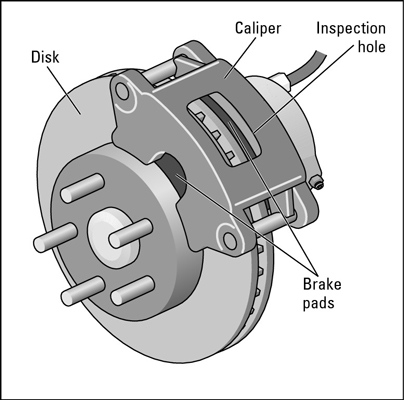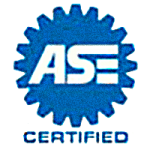The Best Brake Repair & Service In Dover
Do you live in the Dover area? Looking for great local brake repair and service?
You’re in the right place!
Trouble Shooting Guide
Warning signs that your brakes need attention:
– Strange noises or high-pitched squeaking when braking.
– It takes longer for your car to stop than usual.
– The steering wheel wiggles in your hands when coming to a stop.
– Unusual shaking or shuddering when you apply the brakes.
– Uneven pulling to one side
– The need to pump the pedal to get better stopping power
High pitched brake squeal or grinding noises when using brakes:
This could mean your brakes need to be adjusted or that your brake pads are worn and need replacement.
When braking your car pulls to one side:
This means your brakes need an adjustment, your brakes are worn out and need replacement.
Dashboard’s ABS light is on:
This either indicates that your brake fluid is getting low, or you have a leak in your brake line. Get it inspected.
The brake pedal is traveling all the way to the floor:
Your brake pedal going all the way to the floor can be caused by a number of reasons. Your brake lines could be leaking fluid. If your vehicle is not leaking any brake fluid, The Master Cylinder is usually the culprit.
Brakes are hard to press down or feel “spongy”:
Usually, this means air has gotten into your brake lines or you may have low brake fluid.
When applying the brakes, your steering wheel, brake pedal, or entire vehicle begins to shake:
If this happens, your brake rotors could be warped and need replacement.
Have Your Brakes Serviced
We recommend servicing your brake pads and shoes, and at the very least inspect them once a year. Make sure you change them when they are worn past specifications.
Brake fluid should be changed every 2 years or 48,000 miles.
Notice any brake warning signs? Contact our staff by phone, email, or request an appointment online and we’ll take care of it!
Your brakes are the most important system in your car
You rely on your brakes to help you stop securely, whenever and wherever you need to. Brakes are an important feature of your vehicle that contributes to your safety. You will inevitably need to have your brakes repaired if you own your vehicle for an extended period of time. Dupont’s provides expert knowledge in brake repair, replacement, and maintenance.
Neglecting your braking system can lead to further damage and increased repair costs. Not having reliable brakes means putting yourself and anyone you drive with at risk. It’s important to pay attention to potential warning signs and make any necessary repairs. Practicing preventative maintenance will save you money down the road. Repairs that are avoidable by having routine maintenance on your brakes.
Our technicians are qualified ASE Certified or Master certified technicians. Our technicians provide an eagle eye’s look at your car. If you think there may be a problem with your vehicle’s brakes, bring your vehicle to Dupont. We have everything that you need to extend the lifespan of your vehicle. If you feel you may be having a problem, come see us. We will treat you like family.
Have a question? Contact Us!
Brake System Overview
The braking system allows the driver to control the deceleration of the vehicle. Your brakes are crucial for safe operations no matter what kind of vehicle you drive.
Brakes ensure your vehicle can come to a complete stop on command. You will need to have your brakes repaired if you own your vehicle for an extended period of time. Brake pads have wear indicators that produce a noise when it’s time to change the pads. It’s common for brakes to feel different when applying pressure after they’ve been wearing for some time.
There are many components that go into your braking system. Disc brakes use rotors, pads, and calipers. Drum brakes use drums, shoes, and wheel cylinders.
There are two types of braking systems used in cars today. Hydraulic and Regenerative braking. Most modern vehicles use a Hydraulic braking system. Some makes and models use a combination of Regenerative Braking and Hydraulic braking system. Ready to learn how your brakes work?

How Your Brakes Work
Many people wonder, what happens when I step my foot on the brake pedal? Well, Applying pressure to the brake pedal releases Brake fluid into a system of tubes and hoses. These tubes and hoses push the brake fluid to each wheel to stop your car.
Pressing your foot down on the pedal engages a plunger located in the master cylinder. Pushing the plunger releases brake fluid to the braking unit of your wheels.
When the brake fluid is initiated, it moves through a network of tubes and hoses. (This is why gradually stepping on the brakes brings you to a slow stop. And stomping on your brakes is a more abrupt stop.) How hard you press on the brakes will reflect how fast the brake fluid travels to your brakes. This keeps your brakes consistent.
Types of Braking Systems
Hydraulic Brakes
There are two types of hydraulic brakes used on vehicles today. Disc Brakes & Drum Brakes. Many vehicles have a combination of both disc and drum brakes. It’s now an industry standard to install disc brakes on all four wheels.

Regenerative Brakes
Regenerative brakes are used in Hybrid, electric, or start-stop technology vehicles. Hydraulic & Regenerative systems use computer controls with input from various sensors.

Components of The Braking System
The difference between disc and drum brake systems is the hardware around the wheels.
Let’s take a look at the components that make up the braking system in most cars.
Brake Pedal
The force applied to the brake pedal determines how much stopping power is created at the wheels. Pressing your foot on the pedal applies pressure to the brakes. The brake pedal is connected to a hydraulic unit that allows it to apply pressure to stop your vehicle with just your foot. This hydraulic unit is called the Master Cylinder.
Master Cylinder
The master cylinder is like a pressure converter. It converts pressure created from the brake pedal into hydraulic pressure at all four wheels. When you press down on the brake pedal you create physical pressure. the master cylinder converts this physical pressure into hydraulic pressure. The master cylinder then pushes fluid into the brakes. The master cylinder houses the brake fluid.
Brake Lines
Brake lines carry brake fluid from the master cylinder to each wheel on your car. Once this hydraulic pressure reaches the wheels, it’s converted to mechanical pressure.
This pressure forces the brake pads to rub against the disc or drum. This friction is what slows the wheel, which in turn, slows down our cars. If the tires maintain traction on the road, the vehicle will continue to slow down until making a complete stop.
Disc Brakes
Disc Brakes consist of a rotor, two brake pads, and a caliper.

Rotor
The rotor looks exactly like a disc; this disc connects to the wheel hub. Rotors are often vented to prevent overheating and excessive wear.
When Dupont’s inspects rotors we check both sides for cracks, unevenness, warping and deep scoring. If a rotor measures thick enough, we may be able to resurface the rotor smooth. We recommend that you replace or resurface your rotors in pairs. This way the thickness remains even as well as the finish for a more appealing wheel.
Brake Pads
For every rotor on your car, there are two brake pads. The brake pads apply pressure to the brake rotors which result in the vehicle slowing down.
Wear Indicators
Brake pads have mechanical and electrical wear indicators. Wear indicators are also referred to as warning sensors.
The mechanical indicator has a thin metal strip that produces a loud squeal after the pad has worn down. This high pitched squeal is a warning to the driver that it’s time to replace the brake pads. This squeal happens without causing any damage to the rotor itself.
The electrical indicator uses a contact point with the rotor. Once the pad has worn to the electrical contact point a dash indicator lamp lights up.
Caliper
The caliper is a type of C-clamp with a piston, the caliper holds the brake pad on either side of the rotor.It converts fluid pressure from the brake lines into the motion of pads pressing against each side of the rotor. Slowing down the vehicle.
Drum Brakes
Drum brake’s consisted a drum, brake shoes, return springs, hold down springs, and a wheel cylinder.

Brake Drum
The brake drum connects to a wheel hub. Drum brakes are no longer the industry standard. If you have a newer vehicle with drum brakes, they are on the back wheels. Drum brakes are like rotors; it may be possible to resurface the drums if they are thick enough. Also just like rotors, Drums should be resurfaced to remain equal as a pair.
Brake Shoes
Brake shoes are located inside the brake drum. Once you step on the brake pedal, the brake shoes are forced against the brake drum which slows your car down.
Wheel Cylinder
The wheel cylinder converts brake fluid pressure inside the brake lines to force the brake shoes against the brake drum.
Wheel Speed Sensors
Wheel speed sensors monitor a toothed sensor ring, some of us at Dupont’s call them tone rings. These sensor rings keep track of the speed of each wheel.
4 Materials of Brake Pads
Brake pads are the most commonly replaced component of your brake system. There are four types of brake pads that are in use today by drivers. The type of pad you have on your car will depend on your vehicle’s needs.

Organic:
This type of brake pad is made from organic materials. Commonly referred to as NAO. These pads are made of materials such as fiberglass, rubber and even Kevlar. These types of pads are softer and don’t create noise, but they tend to wear faster and create a lot of dust.
Semi-Metallic:
These brake pads are anywhere between 30% to 65% metal. Semi-Metallic brake pads are very durable. They also wear brake rotors faster. These pads are made out of steel wool, wire, copper or other metal materials. Also, semi-metallic brake pads may not function well at low temperatures.
Low-Metallic NAO:
These pads are made from an organic formula with copper or steel added to help with heat transfer. This added copper and steel provides the vehicle with better braking. Just like most brakes, there is usually a considerable amount of brake dust. These pads are often noisy when they lose their thickness.
Ceramic:
Created with ceramic fibers and other filler materials. Ceramic brake pads are more expensive than most other types of pads. They are cleaner and produce much lower noise levels. This is due to the higher quality of material in the brake pad. Also, they provide excellent braking and don’t cause a lot of wear on the brake rotors.
Control & Safety Systems
ABS – The Antilock Braking System:
The first computerized system designed to help maintain traction and improve safety. ABS prevents the wheels of a vehicle from locking up when it’s brake pedal is pushed suddenly and with force. The goal is to keep the vehicle in control. The reason is our cars can only be safely steered when its wheels are not skidding.

ABS uses sensors at each wheel to monitor speed. It also uses a hydraulic unit to regulate brake pressure, and a computer to control the system. If ABS detects a potential lock-up, it releases pressure at that one wheel to maintain balance and keep all four tires on the road. You can feel the ABS in action when your brake pedal makes a pulse. Don’t be alarmed this is normal, Don’t pump your brakes just apply consistent pressure. ABS is not designed to help stop the vehicle faster, it’s purpose is to give you, the driver more control.
TCS – The Traction Control System:
Uses sensors to detect when your tires are slipping while speeding up or from a stop. When TCS detects your tires slipping, it adjusts the throttle input to help slow the slipping wheel.

ESC – Electronic Stability Control:
In 2012, the National Highway Traffic & Safety Administration (NHTSA) announced that ESC IS now mandatory. Electronic Stability Control helps the driver maintain control during bad weather situations. It uses sensors to improve the lateral stability of your car by applying brake pressure to any wheel when instability is detected. ESC helps the driver stay on its intended course, lessening the chance of rollovers and skidding.

Parking Brake:
If you own a car you have most likely used your parking brake before… we hope you have. But do you know how it works? The parking brake engages your brake shoes or pads to keep the vehicle from moving while parked. The brake pedal uses brake fluid and the parking brake uses a mechanical cable or motor.
Mechanical Cable Brake:
Either a hand lever or a small pedal located on the far left side of the driver’s foot engages the cable. This cable allows the Park brake to work independently. To help keep the cable from seizing and corroding, use it whenever parking. If this lever or pedal moves more than normal, the cable or brakes may be worn.
Electric Parking Brake:
The EPB uses an electrical button located on the console to engage the brakes when parking. In emergencies, the EPB will communicate with the ABS unit to use the hydraulic system for a more controlled stop.
Have another question? Did we miss something? Send us an email





